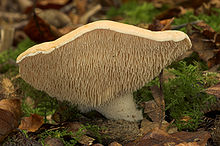Bread stubble mushroom
| Bread stubble mushroom | ||||||||||||
|---|---|---|---|---|---|---|---|---|---|---|---|---|

Bread stubble mushroom ( Hydnum repandum ) |
||||||||||||
| Systematics | ||||||||||||
|
||||||||||||
| Scientific name | ||||||||||||
| Hydnum repandum | ||||||||||||
| L. , 1753 |
The Semmel stubble mushroom or Semmelgelbe stacheling ( Hydnum repandum ) is a widespread and common type of mushroom from the family of stubble mushrooms . The two German names refer to the yellowish hat color , reminiscent of rolls , and the spikes on the underside of the hat. The species is a mycorrhizal fungus and likes to grow under beech and spruce trees . The bread stubble is one of the edible mushrooms . In trade and in the catering trade it is also offered under the name sheep's foot fungus , derived from the French mushroom name "Pied-de-mouton".
The characteristics
Macroscopic features
The hat is 5–10 cm wide and creamy-white, pale yellow to roll-colored. Its surface is dry and matt. There are spines on the underside. These easily run down the handle or are bulged on it. The stem is white and often sits on the side. The meat is whitish and brittle and crumbly. The mushroom smells pleasant. At first it tastes mild, later it is reminiscent of dried oat flakes and becomes spicy after longer chewing. Old specimens are bitter. The spore powder is white.
Microscopic features
The spores measure 6.5–9 × 5.5–8.5 micrometers and are smooth, rounded, and have a large drop of oil. The basidia are usually 3–4-spore.
Ecology and phenology
The bread stubble is a mycorrhizal fungus that can be associated with both deciduous and coniferous trees. It lives in richer beech, beech, fir and fir forests on fresh, loosely humus-rich to loamy soils that are rich in base or low in base and low to moderate in nutrients. It is found less often in spruce, spruce-fir, hornbeam-oak and hardwood forests. In Central Europe, the main tree partners are the red beech and the common spruce , as well as the silver fir , oak , forest pine and other tree species.
The fruiting bodies appear in Central Europe from mid-July to early November.
distribution
The bun mushroom is found in Australia, New Zealand, South Asia, North America, large parts of North Asia, North Africa and the Canary Islands. In Europe, its distribution area includes all countries from the Mediterranean to the subarctic regions. In Germany it occurs in all federal states, but is more common in the mountain and hill country than in the flat country.
meaning
The bread stubble is edible, but its value as an edible mushroom is controversial. While Ryman & Holmåsen identify it as an excellent edible mushroom, Pilát describes it as quite tough and therefore difficult to digest. Cetto rates it as a mediocre edible mushroom that has to be cooked for a long time. Michael , Hennig & Kreisel , however, differentiate that young mushrooms taste good and stay fresh for a long time, while old mushrooms taste bitter and can no longer be used.
Even 30 years after the Chernobyl reactor accident, the level of radioactive 137 Cs is in some areas above the EU limit value for food of 600 Becquerel per kilogram.
Synonyms
Synonyms include: Hydnum rufescens , Dentinum rufescens , Tyrodon repandus , Sarcodon repandus or Hydnum repandum var. Rufescens .
Web links
swell
literature
- German Josef Krieglsteiner (Eds.), Andreas Gminder , Wulfard Winterhoff: Die Großpilze Baden-Württemberg . Volume 2: Stand mushrooms: inguinal, club, coral and stubble mushrooms, belly mushrooms, boletus and deaf mushrooms. Ulmer, Stuttgart 2000, ISBN 3-8001-3531-0 .
Individual evidence
- ↑ Giuseppe Pace: Small mushroom Atlas . Hörnemann, Bonn-Röttgen 1978. P. 298. ISBN 3-87384-441-9 .
- ↑ Sheep's foot fungus - pied de mouton . In: Culinary Dictionary German - French . Retrieved November 16, 2011.
- ↑ a b Ewald Gerhardt: Mushrooms . BLV, Munich 2006. p. 397. ISBN 978-3-8354-0053-5 .
- ↑ Sven Gunnar Ryman, Ingmar Holmåsen: mushrooms . Haymarket Media 1992. p. 107. ISBN 978-3-87815-043-5 .
- ↑ Albert Pilát: Mushroom Pocket Atlas . 8th edition. Werner Dausien, Hanau 1974. p. 32. ISBN 3-7684-2480-4 .
- ↑ Bruno Cetto: The great mushroom guide, vol. 1 . BLV, Munich 1978. p. 573. ISBN 978-3-405-11909-6 .
- ↑ Edmund Michael, Bruno Hennig, Hanns Kreisel: Handbook for mushroom friends, Vol. 1: The most important and most common mushrooms . 5th revised edition. VEB Gustav Fischer Verlag, Jena. 1983.
- ↑ https://www.br.de/nachrichten/wissen/pilze-in-bayern-sind-noch-immer-radioaktiv-RLet,R1w6mbV
- ^ Index Fungorum
- ^ Mycobank
